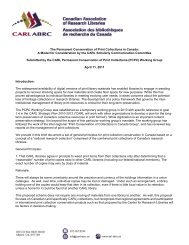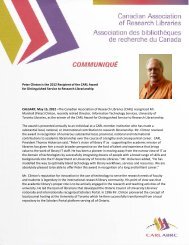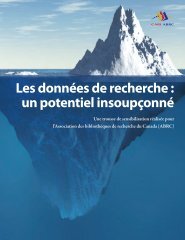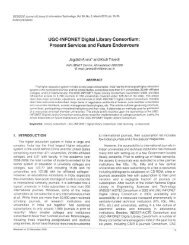PDF - CARL - ABRC
PDF - CARL - ABRC
PDF - CARL - ABRC
Create successful ePaper yourself
Turn your PDF publications into a flip-book with our unique Google optimized e-Paper software.
OCUL digital collection development must be considered when<br />
developing any print storage initiative; 3. costs are a key factor; 4.<br />
the level of print storage facility (i.e., international, national, OCUL<br />
level), if any, must be determined; 5. service and content issues are a<br />
concern; and, 6. if there is an OCUL print storage initiative, preference<br />
for a central or distributed model must be determined.<br />
Library as a Place<br />
The urgent need to relocate physical collections or at least the<br />
ability to plan for longer term collection relocation was an<br />
overarching theme across all of the interviews. Seven institutions<br />
(2VL, 1L, 1M, 3S) were in desperate need for space, four institutions<br />
(1L, 1M, 2S) were tight for space estimating a need in the next 2–3<br />
years, three (1VL, 1L, 1M) believed their space needs were met for the<br />
next 5 years, and six (1VL, 3L, 2S) either did not predict any space<br />
issues for at least 7–10 years or felt they did not have any foreseeable<br />
space needs. One institution desperate for space already had access to<br />
a storage facility. Overall 11 of 20 OCUL institutions (55%) were either<br />
desperate or tight for space. Whether pressed for space or not, though,<br />
all of the directors acknowledged the changing nature of the library as<br />
a place and that planning for new or re-visioned facilities was a central<br />
theme for their libraries and their role as director.<br />
The Importance of Digital Collections<br />
Another common theme was that any planning for print<br />
repositories had to be done as a complement to OCUL's growing<br />
repertoire of digital resources supported and maintained on Scholars<br />
Portal. Tens of thousands of e-journal titles are locally-loaded on, and<br />
available through, Scholars Portal. The shift to digital monographs is<br />
also picking up steam with e-book package deals and monograph<br />
digitization projects becoming more commonplace. OCUL has<br />
invested millions of dollars developing the Scholars Portal infrastructure.<br />
Across all 20 interviews, it was clear that any OCUL print<br />
repository strategy would be directly informed by ongoing development<br />
of Scholars Portal specifically, and more generally, by the broad<br />
shift to digital scholarly communication and scholarly publishing.<br />
Success in making Scholars Portal a trusted digital repository would<br />
have significant impact on what type of print repository, if any, is<br />
necessary. All 20 directors indicated that it was important that<br />
Scholars Portal be recognized as a trusted digital repository (TDR).<br />
Eight further qualified that positive response with questions or<br />
concerns about what it will cost to make Scholars Portal a TDR, what it<br />
means to become a TDR, and what the process is for becoming a TDR.<br />
There was also concern over whether making Scholars Portal a TDR<br />
would slow the continued development of Scholars Portal content and<br />
services.<br />
Costs are a Key Factor<br />
Across all 20 institutions a common thread that emerged was<br />
that any OCUL print storage initiative would have to first and<br />
foremost be sustainable within the member institutions' budgets,<br />
many of which are already constrained. The costs related to any<br />
recommendations for print storage have to be defined. The<br />
availability of any external funding for print storage facility<br />
development is also an unknown. Building facilities for last-print<br />
or low-use print material was seen by most directors as a difficult<br />
sell to external funding agencies. Twelve directors (1VL, 3L, 2M, 6S)<br />
expressed significant concern about the costs and funding of any<br />
print storage strategy, with smaller institutions expressing this<br />
concern more than the large or very large institutions. Many are<br />
already dealing with significant cost outlays for Scholars Portal and<br />
expect further costs in developing Scholars Portal as a TDR. This led<br />
several directors to wonder how they would pay for a print storage<br />
project. Any plans for an OCUL collaborative print storage initiative<br />
246 The Journal of Academic Librarianship<br />
would have to be set in consideration of current and future costs<br />
and funding possibilities. Notwithstanding the funding concern,<br />
however, some of the directors felt it would be feasible to explore<br />
the cost savings that might be realized with a centrally managed<br />
facility. Funding proposals could be made in terms of cost savings in<br />
the space liberated for other uses, in terms of staff and facilities<br />
savings as the need for ongoing management of in-house stacks is<br />
reduced, and in terms of staff savings in areas such as interlibrary<br />
loans as significant amounts of interlibrary loans are directed to one<br />
central facility.<br />
“Across all twenty institutions a common<br />
thread that emerged was that any OCUL print<br />
storage initiative would have to first and<br />
foremost be sustainable within the member<br />
institutions’ budgets, many of which are<br />
already constrained”<br />
What Kind of Print Storage Facility is Needed?<br />
This theme prompted the most discussion and the most diverse<br />
range of responses from the OCUL directors. As they discussed what<br />
type of OCUL collaborative print storage initiative, if any, might be<br />
needed, they considered the storage needs for three main categories:<br />
A. print serial collections that duplicate serials locally-loaded on<br />
Scholars Portal; B. print serial collections not locally-loaded on<br />
Scholars Portal; C. print monographs and government documents<br />
not necessarily duplicated in digital format. Within those three main<br />
categories the responses were grouped based on whether the<br />
respondents felt an international, national, or provincial collaborative<br />
strategy would be most appropriate. Two institutions (1VL, 1L)<br />
questioned the need for any type of coordinated print storage<br />
initiative, so the totals reported below are for 18 institutions.<br />
Journals Locally-Loaded on Scholars Portal<br />
Seven directors (1VL, 2L, 2M, 2S) felt that an international<br />
initiative to store print runs of serials locally-loaded on Scholars<br />
Portal would be sufficient. They felt that Scholars Portal was a stable<br />
and trusted source, so the availability of a last print copy of the<br />
journals on Scholars Portal anywhere in the world would meet any<br />
need for possible future access to the print format. Five directors (1L,<br />
1M, 3S), felt that even though Scholars Portal provided reliable access,<br />
it would be prudent to maintain at least one print run somewhere in<br />
Canada. That is, a national print storage option would suffice. The<br />
uncertainty about future access across national borders was often<br />
cited by those holding this view. Six directors (2VL, 2L, 2S) felt that<br />
OCUL should maintain a provincial level print storage initiative for<br />
journals locally-loaded on Scholars Portal. Three of the six indicated<br />
that ideally a national approach would be the best, but in reality it was<br />
more feasible to implement and maintain a provincial approach.<br />
Digital Serials not Locally-Loaded on Scholars Portal<br />
Six directors (1VL, 2L, 1M, 2S) felt that an international<br />
collaboration for serials duplicated by digital, but not locally-loaded<br />
on Scholars Portal, would suffice. They felt that many of these serial<br />
titles were produced by well-respected commercial publishers or<br />
vendors with lots of copies around the country or around the globe,<br />
thus an international repository would meet OCUL's needs. This was<br />
especially true for collections such as JSTOR, which already has two<br />
print repositories in the United States. 60 Six directors (1L, 2M, 3S) felt<br />
that a national strategy would be best and six (2VL, 2L, 2S) felt that a<br />
provincial strategy was the best route to take. Again, three of the six












